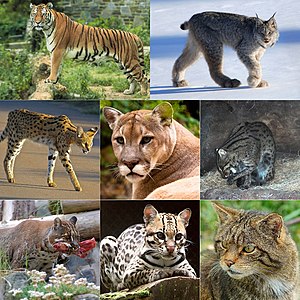Felidae is a family of mammals, in the order Carnivora. Animals that belong to Felidae are called felids.
| Felidae[1] | |
|---|---|
 | |
| Scientific classification | |
| Domain: | Eukaryota |
| Kingdom: | Animalia |
| Phylum: | Chordata |
| Class: | Mammalia |
| Order: | Carnivora |
| Suborder: | Feliformia |
| Superfamily: | Feloidea |
| Family: | Felidae Fischer von Waldheim, 1817 |
| Type genus | |
| Felis | |
| Subfamilies | |
| |
 | |
| Felidae ranges | |
The family is of quite recent origin: the first fossils are from the Oligocene, 25 million years ago (mya). There are 41 living species, including the domestic cat, and they are monophyletic: all descended from the same ancestor.[3]
Characteristics
Felids tend to have lithe and flexible bodies with muscular limbs. In most species, the tail is a third or a half the length of the body, with some exceptions (the bobcat and margay). The limbs are digitigrade, meaning they walk on their toes. The paws have three soft toe pads and retractible claws (usually).[1] The tongue of felids is covered with horny papillae, which rasp meat from prey and aid in grooming.
Classification
The Felidae has three subfamilies:
- †Machairodontinae: sabre-toothed cats.
- Pantherinae: large cats tiger, lion, jaguar, leopard
- Felinae: cougar, cheetah and smaller cats
More examples of felines are the big cats – the lion, tiger, leopard, jaguar, snow leopard, clouded leopard, puma, and cheetah - and other wild cats, for example the lynx, caracal, and bobcat. All felines, also the small pet cat, are predators that can hunt many animals.
Evolution
The felids evolved in Asia and spread across continents by crossing land bridges. DNA sequence analysis shows that ancient cats evolved into eight main lines. There were at least 10 migrations (in both directions) from continent to continent via the Bering land bridge and Isthmus of Panama. The Panthera genus is the oldest and the Felis genus is the youngest. 60 percent of the modern species of cats developed within the last million years.[4]
The felids' closest relatives are the linsangs,[5] and at one remove the group of civets, hyenas, mongooses, and Madagascar carnivores,[6] with whom they share the Suborder Feliformia. All felid species share a genetic anomaly that prevents them from tasting sweetness.[7]
Genetic classification
Genetic research has provided a basis for a more concise classification for the living members of the cat family based on genotypical groupings.[1][8][9] Specifically, eight genetic lineages have been identified:[10]
- Lineage 1: Panthera, Uncia, Neofelis
- Lineage 2: Pardofelis, Catopuma
- Lineage 3: Leptailurus, Caracal, Profelis
- Lineage 4: Leopardus
- Lineage 5: Lynx
- Lineage 6: Puma, Acinonyx
- Lineage 7: Prionailurus, Otocolobus
- Lineage 8: Felis
The last four lineages (5, 6, 7, 8) are more related to each other than to any of the first four (1, 2, 3, 4), and so form a clade within the Felinae subfamily of family Felidae.
Taxonomy
- Subfamily Felinae
- Genus Acinonyx
- Cheetah, Acinonyx jubatus
- Genus Caracal
- Caracal, Caracal caracal
- Genus Catopuma
- Bay cat, Catopuma badia
- Asian golden cat, Catopuma temminckii
- Genus Felis
- Chinese mountain cat, Felis bieti
- Jungle cat, Felis chaus
- Pallas' cat / Manul, Felis manul
- Sand cat, Felis margarita
- Black-footed cat, Felis nigripes
- Wildcat, Felis silvestris
- Domestic cat, Felis silvestris catus
- Genus Leopardus
- Pantanal cat, Leopardus braccatus
- Colocolo, Leopardus colocolo
- Pampas cat, Leopardus pajeros
- Geoffroy's cat, Leopardus geoffroyi
- Kodkod, Leopardus guigna
- Andean mountain cat, Leopardus jacobitus
- Ocelot, Leopardus pardalis
- Oncilla, Leopardus tigrinus
- Margay, Leopardus wiedii
- Genus Leptailurus
- Serval, Leptailurus serval
- Genus Lynx
- Canada lynx, Lynx canadensis
- Eurasian lynx, Lynx lynx
- Iberian lynx, Lynx pardinus
- Bobcat, Lynx rufus
- Genus Pardofelis
- Marbled cat, Pardofelis marmorata
- Genus Prionailurus
- Leopard cat, Prionailurus bengalensis
- Iriomote cat, Prionailurus iriomotensis
- Flat-headed cat, Prionailurus planiceps
- Rusty-spotted cat, Prionailurus rubiginosus
- Fishing cat, Prionailurus viverrinus
- Genus Profelis
- African golden cat, Profelis aurata
- Genus Puma
- Puma, Puma concolor
- Genus Acinonyx
- Subfamily Pantherinae
- Genus Neofelis
- Clouded leopard, Neofelis nebulosa
- Sunda clouded leopard, Neofelis diardi
- Genus Panthera
- Genus Uncia
- Snow leopard, Uncia uncia
- Genus Neofelis
Related pages
References
Wikiwand in your browser!
Seamless Wikipedia browsing. On steroids.
Every time you click a link to Wikipedia, Wiktionary or Wikiquote in your browser's search results, it will show the modern Wikiwand interface.
Wikiwand extension is a five stars, simple, with minimum permission required to keep your browsing private, safe and transparent.
